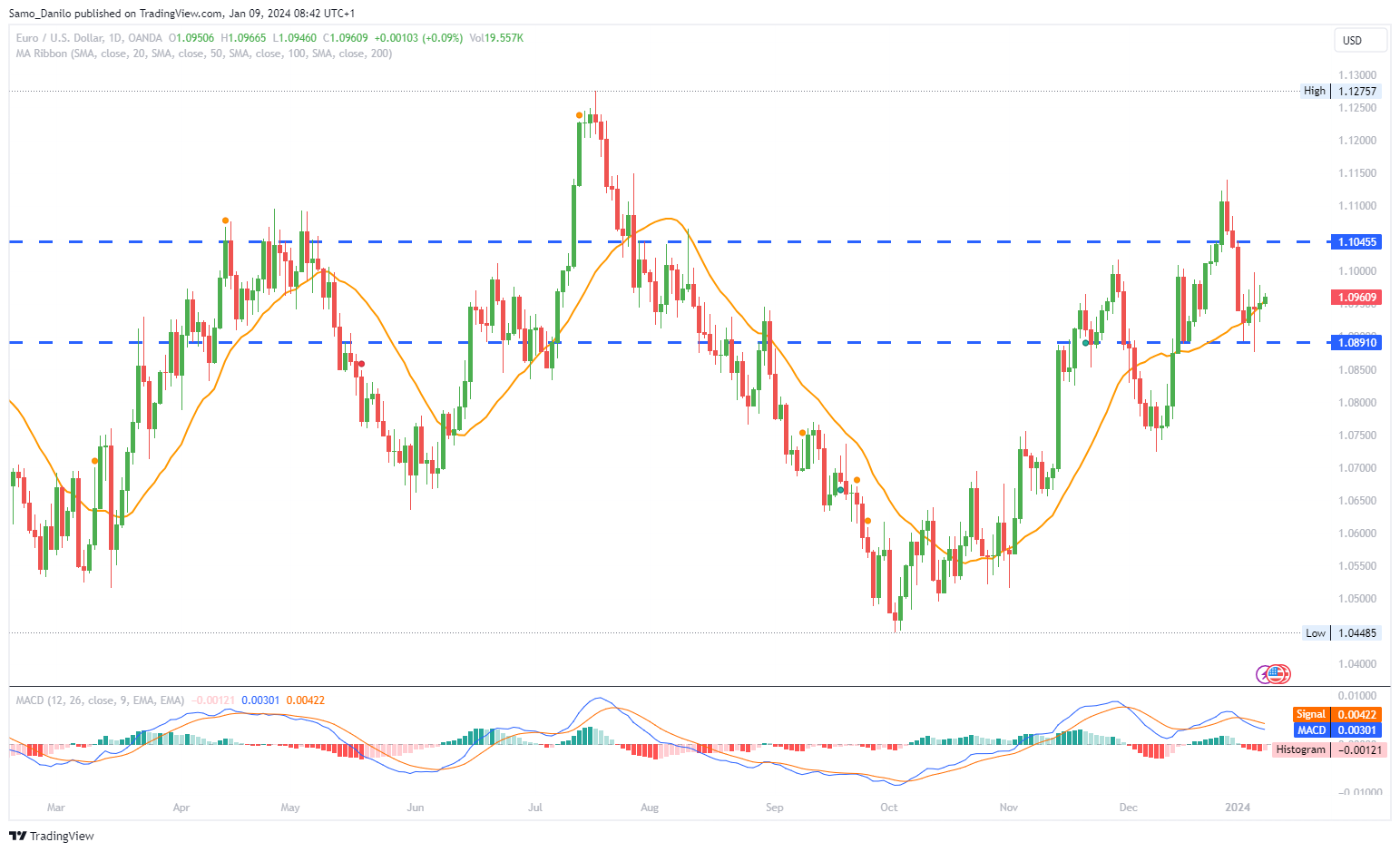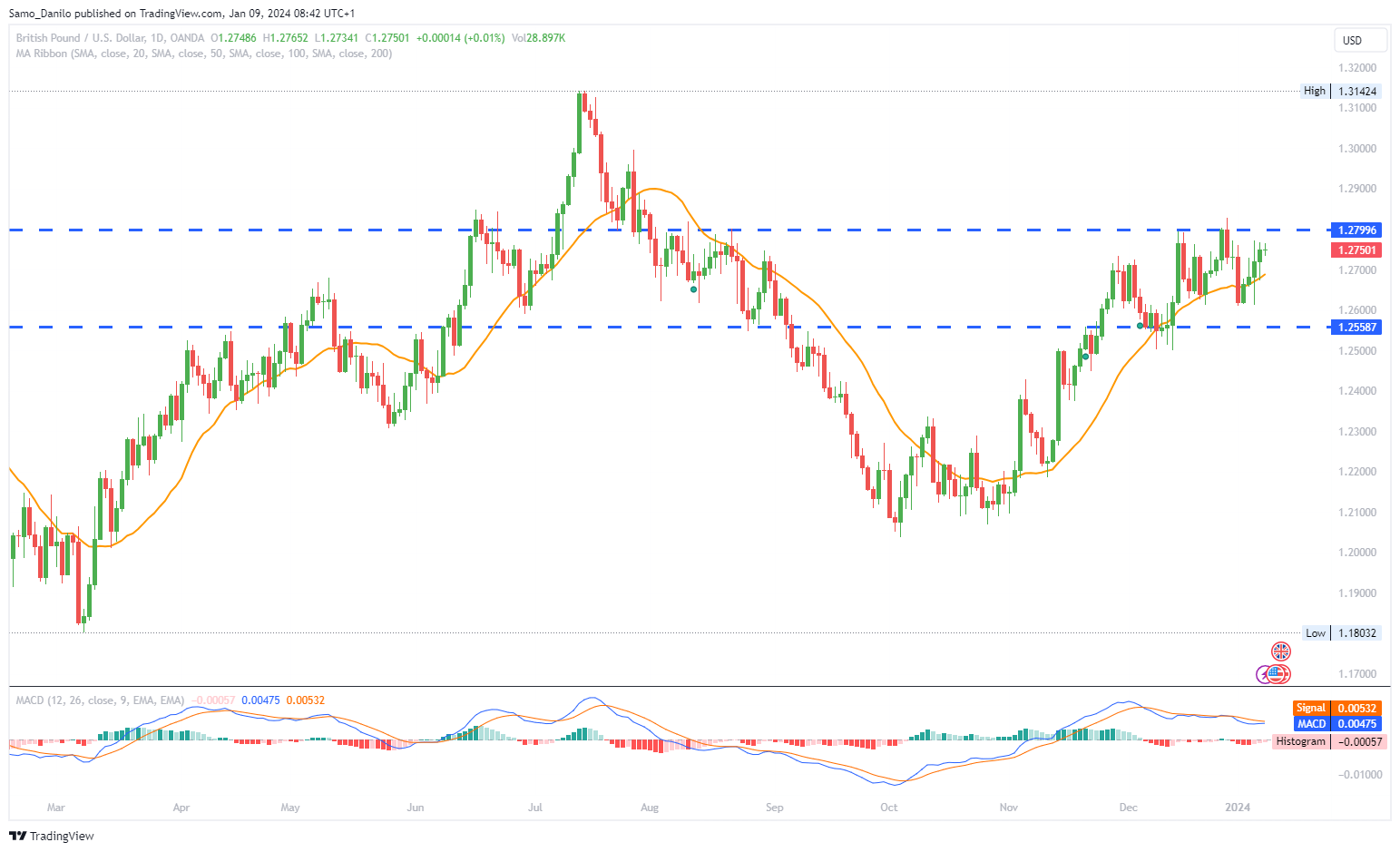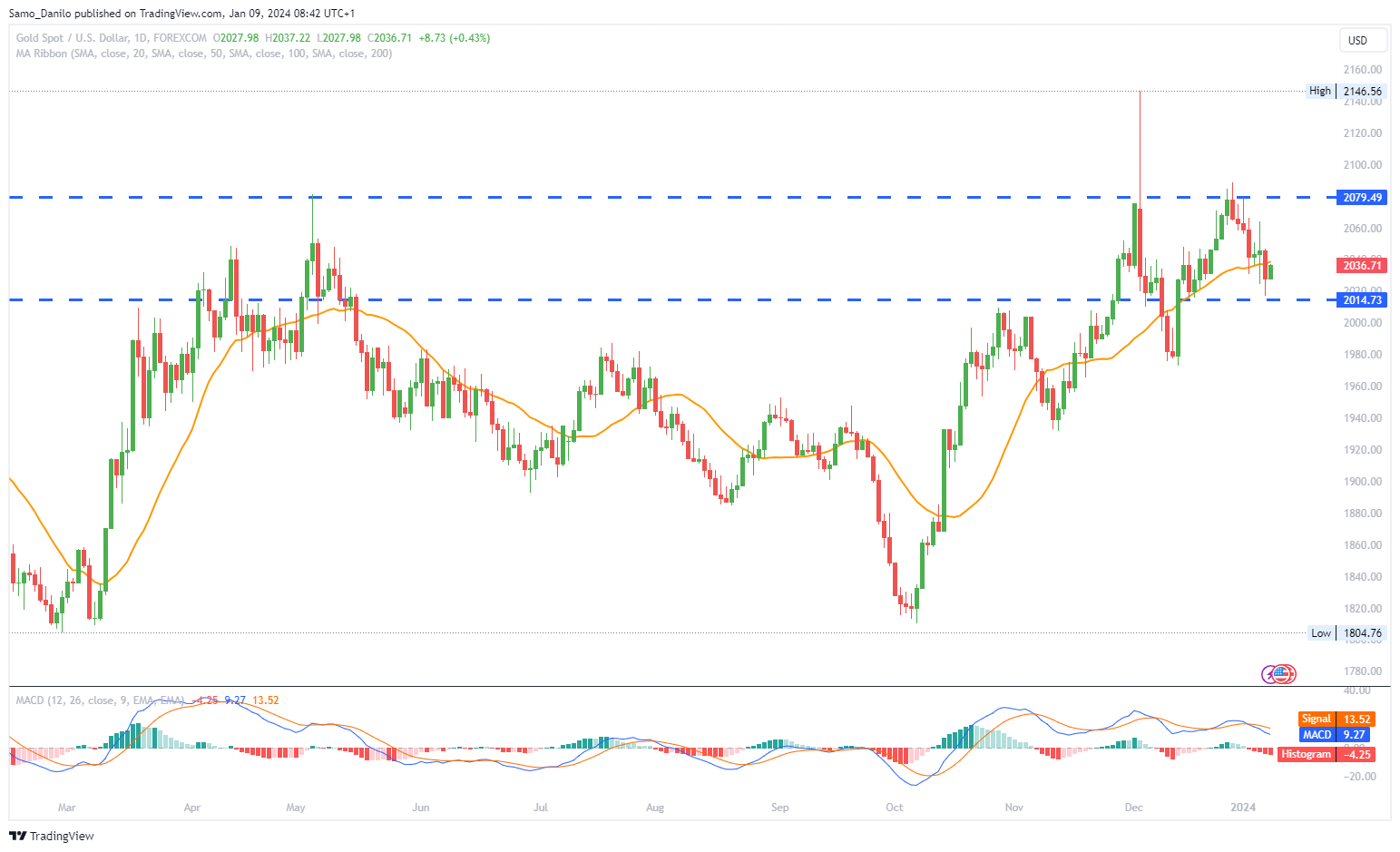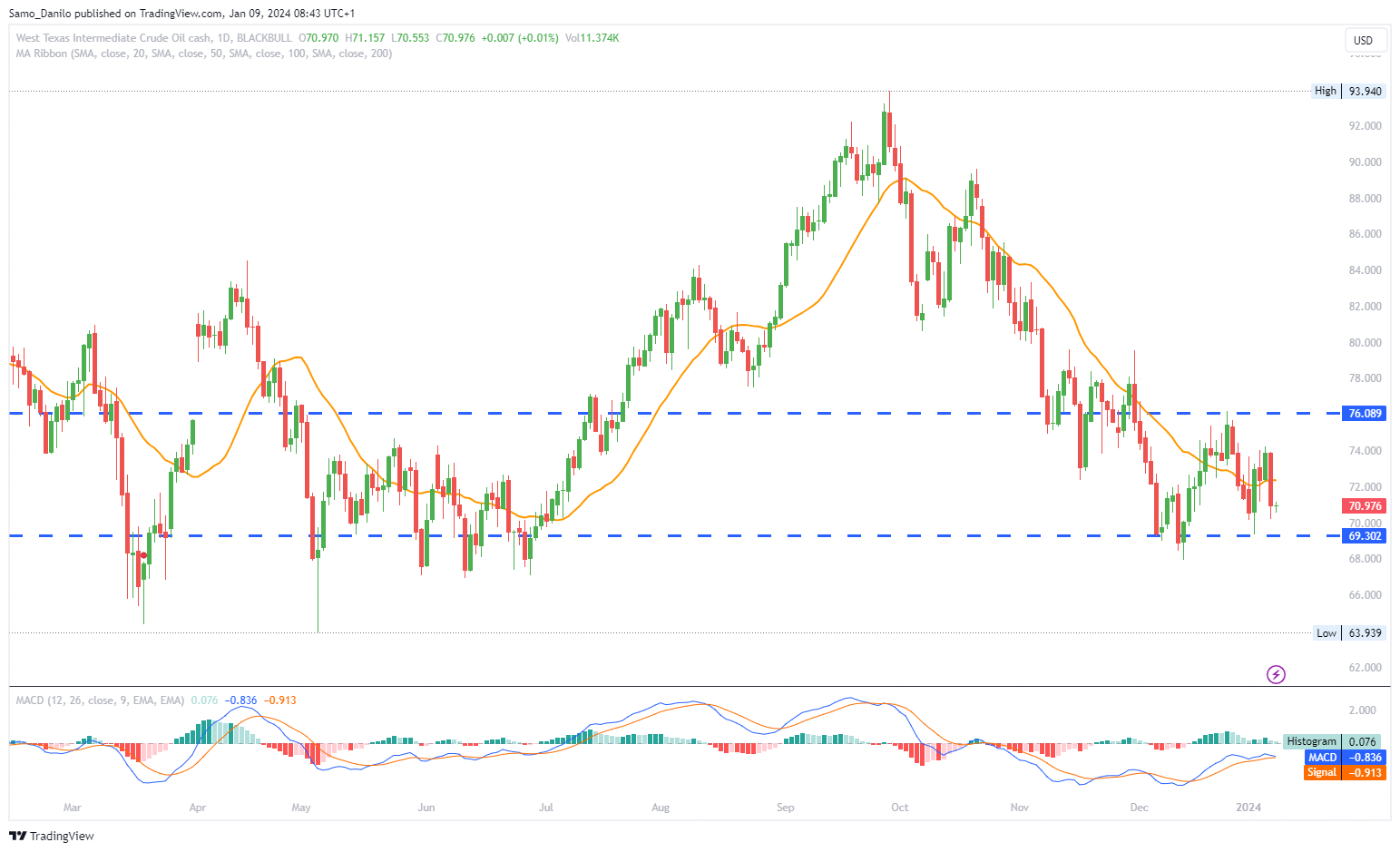EURUSD
- EUR/USD is facing challenges and is trading close to 1.0950 in European trading on Tuesday. This struggle comes after a couple of sessions with inconclusive price action despite stronger-than-expected Payrolls results for December, with 216K jobs added.
- The USD Index (DXY) is experiencing renewed selling pressure, reversing a trend of inconclusive movements. This follows speculation about potential interest rate cuts by the Federal Reserve early in the spring.
- The macro environment is dominated by the dynamic plans of the Federal Reserve, considering interest rate reductions. In contrast, the European Central Bank (ECB) has maintained a relatively muted stance, with consensus placing a potential rate cut later in the year.
- Euro's upbeat sentiment is contributed to by the improvement in Investor Confidence tracked by the Sentix Index, which stood at -15.8 in January. Additionally, the unchanged final Consumer Confidence reading from the European Commission for December at -15.0 adds to the positive tone.
- Despite the positive indicators, Retail Sales in the Eurozone contracted, showing a decline of 0.3% MoM in November and 1.1% over the last twelve months.
Closing statement: EUR/USD faces a challenging environment as the focus remains on the contrasting dynamics between the Federal Reserve and the European Central Bank. The struggle around 1.0950 reflects the uncertainty and delicate balance in the market. The positive Euro sentiment from certain indicators is counteracted by concerns about economic indicators like Retail Sales in the Eurozone. Traders will closely monitor central bank communications and economic data for clearer directional cues.
GBPUSD
- GBP/USD is retracing and heading back toward 1.2700, unable to sustain levels above 1.2750 in early European trading on Tuesday.
- The US Dollar (USD) gained strength against major currencies following the initial knee-jerk reaction to the December jobs report. However, it struggled to maintain its bullish momentum.
- The December Nonfarm Payrolls in the US increased by 216,000, surpassing market expectations of 170,000. However, the disappointing ISM Services PMI and revisions to November and October prints in the labor market data limited the bullish momentum.
- Despite the strong jobs report, the underlying details and the ISM Services PMI didn't alleviate concerns about a potential Federal Reserve policy pivot in March. Traders are cautious, and bets on a policy shift continue.
- Market participants are looking ahead to the Consumer Price Index (CPI) data from the US, scheduled for release on Thursday. This data could be a significant driver for the next market moves.
| SMA (20) | Rising |
|
|
| RSI (14) | Neutral | ||
| MACD (12, 26, 9) | Falling |
|
|
Closing statement: EUR/USD faces a challenging environment as the focus remains on the contrasting dynamics between the Federal Reserve and the European Central Bank. The struggle around 1.0950 reflects the uncertainty and delicate balance in the market. The positive Euro sentiment from certain indicators is counteracted by concerns about economic indicators like Retail Sales in the Eurozone. Traders will closely monitor central bank communications and economic data for clearer directional cues.
GOLD
- The near-term technical outlook for gold price slightly favors buyers, but the key level to watch is the acceptance above the 21-day Simple Moving Average (SMA) situated around $2,042.
- Expectations of a dovish stance by the Federal Reserve were reinforced as the latest Survey of Consumer Expectations by the New York Fed indicated that US consumers' short-term inflation projections fell to the lowest level in nearly three years in December.
- Currently, markets are pricing in approximately 61% odds of a Fed rate cut in March. This has increased from a 55% chance observed after the release of the upbeat US Nonfarm Payrolls (NFP) report.
- All eyes are now on Thursday’s release of the US Consumer Price Index (CPI) data. This data is crucial as it will impact market expectations for Fed rate cuts, influencing both the US Dollar and Gold price valuations.
- The broader market sentiment and expectations regarding the Federal Reserve's monetary policy will continue to play a significant role in determining the price direction of Gold, considering its status as a US Dollar-denominated asset.
| SMA (20) | Rising |
|
|
| RSI (14) | Neutral | ||
| MACD (12, 26, 9) | Slightly Falling |
|
Closing statement: Gold's technical outlook is slightly in favour of buyers, contingent on it maintaining levels above the 21-day SMA around $2,042. The dovish Fed expectations, reinforced by consumer sentiment data, have influenced market pricing for a March Fed rate cut. Traders are eagerly awaiting the US CPI data on Thursday, which will likely shape the near-term trajectory of both the US Dollar and Gold.
CRUDE OIL
- West Texas Intermediate (WTI) price is hovering near $70.70 per barrel during the Asian session on Tuesday. The prices are currently consolidating after experiencing losses in the previous session.
- The ongoing geopolitical conflict between Israel and Gaza is a key factor influencing Crude oil dynamics. Historical patterns indicate that geopolitical tensions in the Middle East often raise concerns about potential disruptions in oil supply, leading to increased volatility in oil markets.
- US Secretary of State Antony Blinken has issued a warning regarding the Gaza conflict, emphasizing the broader implications of the situation. Blinken's visit to Tel Aviv for discussions with Israeli officials and talks with Arab leaders reflects diplomatic efforts to address and find a resolution to the ongoing conflict.
- The reported increase in the output of the Organization of the Petroleum Exporting Countries and its allies (OPEC+) in December, reflecting a rise of 70,000 barrels per day (bpd), has contributed to the recent depreciation of crude oil prices. This suggests an adjustment in the global oil supply.
- Saudi Arabia's decision to reduce the February Official Selling Price (OSP) of its flagship Arab Light crude to Asia is notable. This reduction marks the lowest level in 27 months and is a strategic move with significant implications for oil markets.
| SMA (20) | Falling |
|
|
| RSI (14) | Slightly Falling |
| |
| MACD (12, 26, 9) | Slightly Rising |
|
Closing statement: Crude oil prices are currently consolidating, influenced by a mix of geopolitical factors, diplomatic efforts to address conflicts, adjustments in OPEC+ output, and strategic pricing decisions by major oil-producing nations like Saudi Arabia. The ongoing situation in the Middle East and global diplomatic efforts will likely continue to impact oil market dynamics in the near term.
DAX
- On Monday, economic indicators from Germany provided mixed signals. While factory orders rose modestly, they fell short of forecasts. However, trade data revealed a pickup in global demand, with exports increasing by 3.7%, and imports up 1.9% in November. The positive trade data helped cushion the impact of the factory order numbers.
- The Sentix Indicator for January continued to signal concerns about a German recession. This impacted the demand for stocks listed on the DAX, as investors remained cautious about the economic outlook.
- On Monday, US Consumer Inflation Expectations decreased from 3.4% to 3.0% in December. The softer inflation outlook for the next 12 months supported the appetite for riskier assets, which could have influenced the sentiment in the equity markets, including the DAX.
- Today, German industrial production will be in focus. Following the mixed economic statistics from Monday, a larger-than-expected increase in industrial production could help ease fears of a German recession. Positive industrial production data might have a favorable impact on DAX-listed stocks.
- Later in the session, investors will consider Eurozone unemployment figures. However, unless there is a marked increase in the unemployment rate, the impact on the DAX is expected to be limited.
| SMA (20) | Rising |
|
|
| RSI (14) | Slightly Falling |
| |
| MACD (12, 26, 9) | Falling |
|
|
Closing statement: The DAX is influenced by a mix of domestic and global economic factors. Investors are closely monitoring German industrial production data for signs of economic health. Concerns about a potential German recession persist, and positive data may help alleviate some of these concerns. Additionally, global economic conditions, including US inflation expectations, continue to play a role in shaping market sentiment.




